Edel Pils: Germany, 1950s
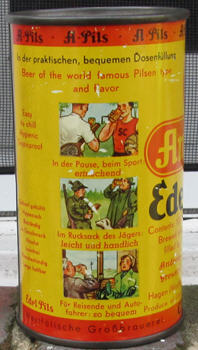 |
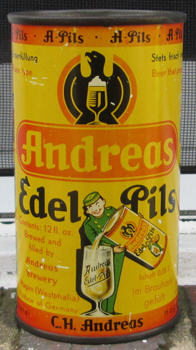 |
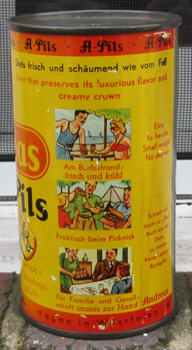 |
This month I am featuring this neat German can from the early 1950s. I like it because its side panels feature arguments about the convenience of beer in cans that echo some of the US ads in the 1930s.
When beer in cans was first marketed in the US in 1935 the canning companies and the breweries that used them had to overcome some consumer reluctance about buying beer in this odd metal container. Vegetables like peas and beans came in cans, not beer! US ads played up several advantages to the beer can.
It was lighter than bottles.
It was convenient to take on
things like picnics.
It was easy to dispose of as there was no deposit. Just throw it away!
It cooled quicker than bottles.
It protected the contents from light, which can skunk beer.
The German cans shown here makes some of the same arguments, although not all. They ignore the deposable nature of the can and how it protected beer from light. Instead they play up the convenience factor. Here are some close-ups of the panels and their translations.
 |
This panel reads:
"In a break [during] sports: refreshing"
"In the backpack of hunters: light and handy"
"For travelers and motorists: convenient" |
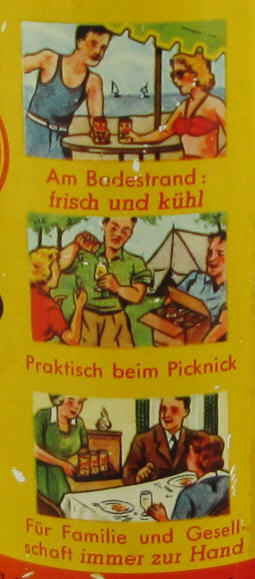 |
This side panel claims cans are...
"On the beach: fresh and cool"
"Practical when picnicking"
"For family and company (society) always at hand" |
Contrast this with the 1930s American ad showing a fisherman throwing his empty can into the lake to dispose of it!
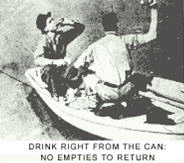 |
"Hey Bill, bet you a buck I can hit that fish on the head with this can!" |
This isn't exactly surprising. The Europeans did not have the same disposable consumer goods culture that developed in America. Not that Europeans didn't toss out empty beer cans, but they didn't have ads encouraging it, and they didn't throw them out as often. That is probably a big reason why beer can dumping was never as big a part of the hobby in Europe as it is in the US. Actually, one of the more popular forms of can dumping in western Europe is digging up US cans from GI foxholes from 1944-1945. I actually have one in my collection. (Note, Japanese cans also warned you not to toss empty cans from your car window!)
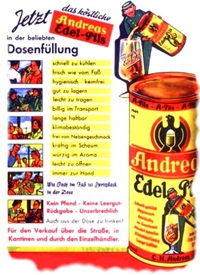 |
On the other hand, the German can shows much the same activities being enjoyed with beer as did ads in the US: picnicking, on hunting (and fishing) trips, with friends, on the beach, with dinner, etc. They do mention that cans are "light." as did American ads. And the claim that cans are "On the beach: fresh and cool" echoes the American claim that cans cool faster than bottles.
The Brewery
OK, what about the C.H. Andreas brewery? It was founded in 1860 by Friedrich Schölling in Westfalia. (He had opened another brewery in 1848). He was joined in 1870 by Carl Ernst Andreas, who cemented his position in 1874 by marrying Schölling's daughter, Adelheid. Andreas would not be the first young brewer who married his boss's daughter. For example, Frederick Pabst married the daughter of Milwaukee brewer Phillip Best and eventually Best Brewing became Pabst Brewing.
Ok, back to Germany. In 1884 the brewery was renamed Schölling Andreas OHG. In 1888 Frederick Schölling died and his name was dropped from the company name. Andreas' sons took over the brewery when he died in 1906. The brewery survived World War One (1914-1918) but restrictions on brewing due to severe grain shortages caused it to be closed for a time.
Near the end of the war in 1918, they merged with Actienbrauerei from Gevelsberg with Andreas as the senior partner. The Andreas family continued adding other breweries to their holdings. In 1933 Carl Ernst Andreas' grandson Carl Horst Andreas, took over what was now the Andreas Brauerei AG. As in World War One, the brewery had to suspend production due to shortages during World War Two.
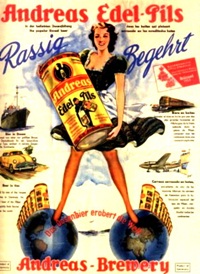 |
By 1950 the brewery was back on production, brewing 80,000 HL (hectoliter). One HL is about 26.4 US gallons. So 80,000 HL is about 68,100 US barrels of beer. By 1955 that had increased to 200,000 HL (170,400 barrels). That would make it a small to medium sized regional brewery in US terms at the time, but it was serving a smaller market.
Production does not seem to have increased a great deal in the years after. In 1981 it was 230,000 HL. In 1994 the brewery was sold and it closed in 1995. However, the name Andreas Brewery is still used by the Dortmund Actienbrauerei to make Andreas Pils.
Sources Used
Hasper Gold (in German) Note: I found the two Edil Pils ads I used on the Hapser Gold site. I emiled the site owner for permission to use them, but the notes bounced back. If the site owner sees this, please email me. Thanks. I'd love to have larger copies!
